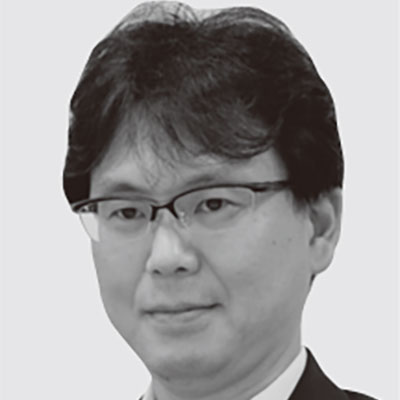Social Innovation through Global Customer Co-creation
Up to now, the utility services that underpin society have been expected to provide universally available and highly reliable services. However, it is becoming difficult to maintain and improve reliable service deliveryt in the face of increasingly complex socioeconomic conditions and the challenges confronting cities, including urbanization and falling birthrates. Accordingly, along with the ongoing need to maintain the security of service supply, there is not only a need to reduce further the cost of utilities and infrastructure operations, but also a need to achieve competitiveness in an environment of liberalizing regulatory reforms. Hitachi is proposing a solution that uses digital technologies for the management and operation and maintenance of utilities and infrastructure. Together with an overview of the solution, this article describes the concept behind the solution, which involves linking executive decisions and field operations through performance indices to improve the efficiency of business processes and management.

Customer Co-creation Project, Global Center for Social Innovation – Tokyo, Research & Development Group, Hitachi, Ltd. Current work and research: Research and development of information systems and services for the energy industry. Society memberships: The Institute of Electronics, Information and Communication Engineers (IEICE) and the Information Processing Society of Japan.

Customer Co-creation Project, Global Center for Social Innovation – Tokyo, Research & Development Group, Hitachi, Ltd. Current work and research: Research and development of information systems and services for the energy industry. Society memberships: IEICE.

Customer Co-creation Project, Global Center for Social Innovation – Tokyo, Research & Development Group, Hitachi, Ltd. Current work and research: Research of energy information systems. Society memberships: Senior member of the Institute of Electrical Engineers of Japan.
Figure 1—Basic Concept of the KPI Tool (Linking Executives and Field Operations)
 The concept is to link executive decisions to field operations by using a KPI tool that supports business activities in a way that responds to the changing societal environment.
The concept is to link executive decisions to field operations by using a KPI tool that supports business activities in a way that responds to the changing societal environment.
Infrastructure plays a crucial role in economic development, technological innovation, and cultural vitality. The Japanese government defines 13 fields of critical infrastructure(1), including information and communications services, railway services, electric power supply services, gas supply services, and water services. Together, these underpin the functioning and development of society. However, the social environment that this infrastructure serves is changing rapidly. Along with the increasing uncertainty surrounding the economic activity associated with complex supply chains, severe environmental challenges, and urbanization, the aging of assets in advanced countries is making it more difficult to operate infrastructure, which, traditionally, has been reliable and affordable.
Against this background, consideration has been given to changing the regulatory framework, for example deregulation, to stimulate competition in the market, and to making modifications to promote more affordable and better quality of services even within regulated business domains.
Achieving this requires different executive administration than in the past for utility and infrastructure operations, including not only cutting costs and ensuring the security of service supply, but also establishing new business competitiveness by creating competitive markets in areas that were previously subject to regulation.
Using its unique methods for collaborative creation with customers, Hitachi is working on developing a solution that uses digital technologies to advance the operation and maintenance (O&M) of assets in utility companies.
While outlining the matters discussed above, this article describes the solution's concept for improving management efficiency at power companies, which links executive decisions and field operations through key performance indicators (KPIs) (see Figure 1).
Utility companies are facing changes in the structure of society and increasing uncertainty surrounding economic activity.
Regarding changes in population distributions, issues may include, for example, urbanization and falling birthrates. Urbanization is giving rise to problems such as distortions in the population pyramid, including depopulation and the concentration of the population in a single region. While there is a need to reinforce assets to meet rising demand in growing regions, infrastructure is placing a greater financial burden on regions with falling populations, resulting in unfairness in service pricing. Meanwhile, the problem of an aging population and falling birthrates is shrinking the workforce, leading to a shortage of people to operate utilities and infrastructure, and posing an obstacle to inheriting know-how from skilled engineers.
Furthermore, procuring the equipment and energy sources for utility services is increasingly prone to being influenced by the global economy. Along with unpredictable risks, such as geopolitical conflict and extreme weather, the associated fluctuations in material and fuel prices have been giving rise to even greater uncertainty than in the past due to increasingly complex supply chains.
These circumstances make it important for utility company executives to have the capability to respond to these changes without simply charging the extra costs to consumers. So, the Internet of Things (IoT) is becoming recognized as a digital technology for assisting the decision-making of these executives and is expected to enable an effective response to this challenge by collecting and analyzing large quantities of information from inside and outside the organization and collaborating with other systems.
Numerous utility companies have used information systems to enhance and streamline their O&M. In most cases, information systems are used to enhance control systems, achieving efficiency improvements through measures such as the analysis and visualization of data on asset status and operations collected from sensors. To facilitate business continuity planning and the ability to integrate systems across multiple technology suppliers, technology standards have enabled a degree of interoperability between these different assets and systems(2).
A benefit of the IoT is that it dramatically extends outcomes from these functions. For example, collecting and analyzing external data that were difficult to obtain in traditional control systems can help identify the approaches to solving numerous problems. For example, making appropriate decisions about asset enhancement and downsizing in response to the changes in demand associated with urbanization can be achieved by using artificial intelligence (AI) for long-term and short-term forecasting. How to inherit the knowledge of O&M practices built up in the field has become a problem as the workforce shrinks due to a falling birthrate, and this can be resolved by efficiency improvements that utilize augmented reality. Alternatively, integrating this know-how into machine systems has the potential to enable high-quality infrastructure O&M to be provided even by engineers who have not acquired such skills.
Furthermore, when assessing the impact on operations of things like geopolitical conflict or extreme weather, predicting fluctuations in demand and fuel prices is important for improving the competitiveness of operators in the energy field, such as gas wholesale companies and power generators. It can also enable a rapid and effective response through interoperation with the systems of other companies or other divisions within the same company.
Numerous challenges remain before actual value can be derived from the IoT. As with systems and solutions adopted in the past, there is a need to link services and business operations in the design of business processes for service providers. Moreover, linking decision-making by executives and field operations is even more important than in the past. For example, executives at service providers redefine executive management policy or rearrange internal resources to respond to dynamic changes in society that they become aware of through the IoT. However, it is difficult to take advantage of business opportunities unless these dynamic actions by executives are followed by relevant actions in the field.
What is important for achieving preparedness for a dynamic response is not only to adopt the IoT, but also to use other digital technologies that maintain the links between executives and the field more dynamically and more tightly.
To engage in effective collaborative creation with customers in the use of IoT platforms(3) for Social Innovation, activities by Hitachi include sharing its vision with customers, creating new concepts, and designing ecosystems along with the use of NEXPERIENCE(4), the Hitachi methodology for collaborative creation with customers. This enables Hitachi to take maximum advantage of the strengths of its IoT platform, which include various forms of data processing, AI techniques, and analytics and visualization techniques. This collaborative creation is supporting development of the solutions linking the executives of customers in the infrastructure sector and the field.
The following section describes a proposal for using a KPI tool that links executives and the field based on the application of the IoT to a thermal power generation company.
This section describes the concepts behind a KPI tool that helps make utility companies more responsive to a rapidly changing societal environment.
The following is a representative use case.
The concept behind the KPI tool is to link executive management policies and field activities, while also allowing KPIs that can be handled quantitatively to be linked and exchanged between executives, the field, and others in each business department.
A thermal power generation company generates electric power to achieve the power generation plan it has committed itself to in advance by purchasing fuel from an external supplier and burning it to produce motive power to drive generators. If the company is unable to operate as planned because an asset fails, it must either use an alternative means of generation instead, or procure the power externally. That is, if the amount of power generated differs from the amount the company has committed to, then it must pay an imbalance penalty.
Although the portfolio of primary energy sources is changing due to the increasing adoption of renewable energy, factors such as the affordable unit price for generation and great flexibility will continue to place heavy demands on thermal power generation in the future. However, especially in advanced countries, operating practices are continuing to change due to aged existing assets, which incorporate higher technical risk of failures. Rather than using thermal power to supply base load, for which conventional planning is comparatively simple, thermal power is increasingly being called on by countries to meet peak demand and to adjust for fluctuations in renewable energy. This changing role is influencing the management practices of thermal power generation companies. In other words, the business is becoming one that demands competitiveness by generating power when it has the most value.
When thermal power serves as a flexible power source, advance commitments are determined according to the market prices of fuel and wholesale power. They also require that asset status is taken into consideration. A certain level of maintenance is needed as performance degrades and failure factors such as loss of airtightness increase due to the buildup of soot as generation assets are kept in operation over time. This means that advance commitments also need to involve adjusting the timing of maintenance.
Given the growing proportion of aging assets, it is vital to realize field operations that are responsive to executive policy changes in a prompt manner, and executive capability to monitor the status of the field. This will lead to competitive generation plans, for example, ones that consider economic decisions on the dates for maintenance and repair. To achieve this, Hitachi is studying operational practices that link executive KPIs and field KPIs.
Development of the KPI tool has involved the following two points.
The first point is the modeling of the KPI tree. There are executive KPIs and field KPIs. The KPI model was developed by modeling each of these separately and then linking them together.
The second point is the quantification and visualization of the costs and benefits of initiatives. This involves quantifying both the human and financial resources required to implement initiatives in the field and the anticipated benefits, and visualizing them in the form of the above KPIs.
The KPI tool provides a high level of visibility and usability for business operations, having been developed based on Hitachi's operational know-how in all aspects of control systems, including power generation, and knowledge of user interface design in the solutions for power industries. It provides effective business operation improvements by implementing the logical structure of the KPIs as a digital model and integrating it with data from the field or other external sources as well as associated predicted values.
This section describes the above representative use case, which is targeted at executives and field users (field managers) (see Figure 2).
Executives use the Executive portal screen to monitor media reports, economic indicators, and the status of each plant within the company (see Figure 3). When executives identify an event requiring a response, the procedure is as follows. The executives respond to the event by resetting the executive KPIs, and use the KPI tree view screen to select KPIs and determine their values and ranges using the screen, the KPI parameter setting. The KPIs and target values determined by the executives in this way are converted by the KPI tool into field KPIs and their associated target values, which can then be confirmed on the Manager portal screen.
Field managers view these new field KPIs and associated target values, and plan improvements that will achieve them. To do this, it is necessary to select improvements that are subject to time and funding constraints, and to formulate action plans for implementing them. Managers can use the Planning, Solution list, and Planning detail screens to see the anticipated benefits of different improvements and improvement timings as they formulate plans. People in the field then put those plans into practice.
Executives use the KPI evaluation screen to see whether the initiatives implemented in the field have resulted in improvements in the executive KPIs.
Hitachi has already built a prototype of the tool and is having it evaluated by experts. It is also being marketed to customers, with assessment of the tool's benefits and commercialization being undertaken through collaborative creation with customers.
Figure 2—Screen Transition Example Demonstrating the KPI Tool for a Thermal Power Generation Company
 The sequence shown in the figure indicates how the link is achieved between user 1 (an executive) and user 2 (a manager in the field). This enables field personnel to take actions to achieve the KPI targets set by the executive. Similarly, the executive can assess the results.
The sequence shown in the figure indicates how the link is achieved between user 1 (an executive) and user 2 (a manager in the field). This enables field personnel to take actions to achieve the KPI targets set by the executive. Similarly, the executive can assess the results.
This article has described aspects of Social Innovations in O&M, in particular as it applies to infrastructure in the various fields that underpin society. The aim is to deliver sustainable, highly reliable, and affordable services that adapt to a changing external environment and internal factors. In undertaking this work, Hitachi is not only deploying its own distinctive technologies, but also treating development as an exercise in collaborative creation with customers. The example application described here is from the power generation business.
To help create a sustainable society that is safe, secure, and comfortable, Hitachi intends to continue using collaborative creation with customers to deliver solutions based on this concept.